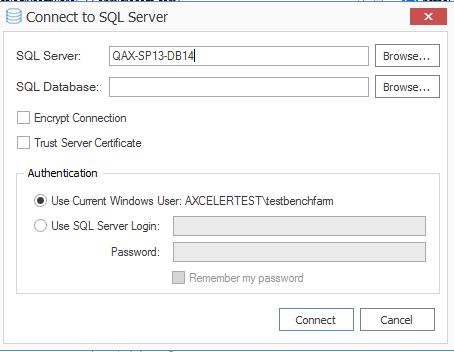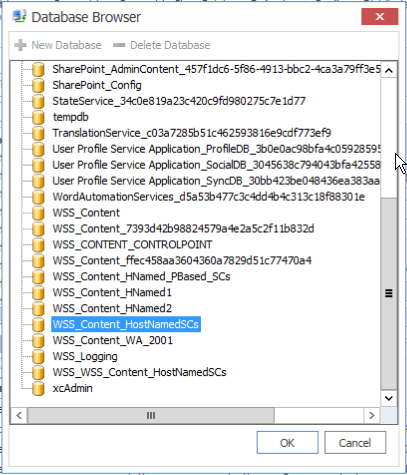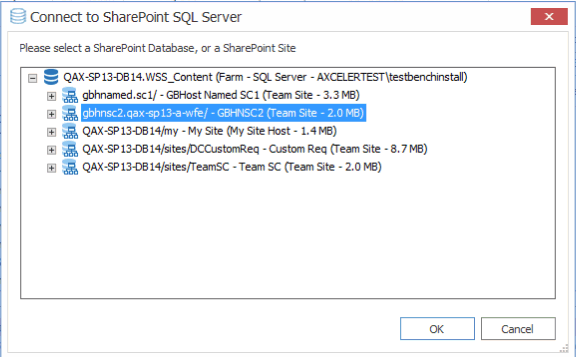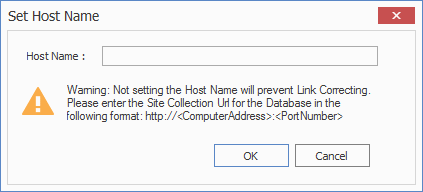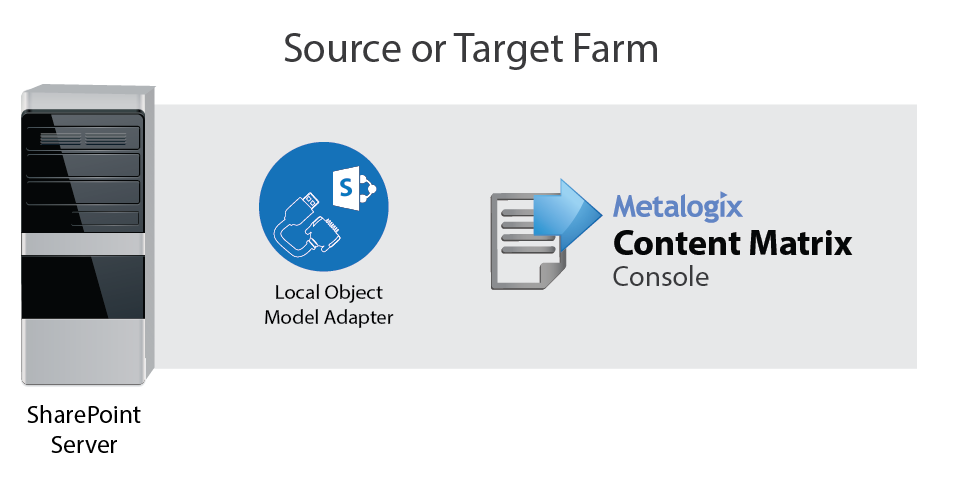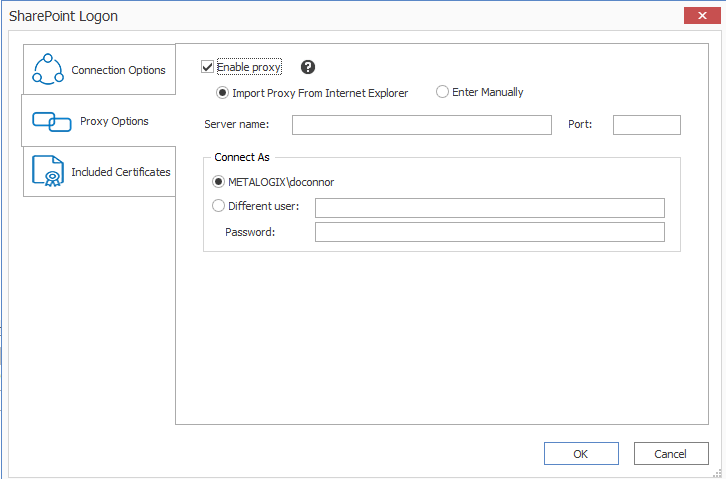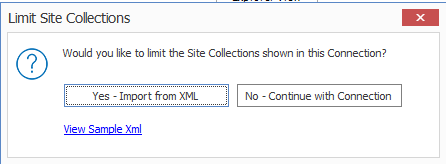Connecting to SharePoint On Premises
|
Navigation: Connecting to SharePoint > Connecting to SharePoint On Premises |
You can connect to SharePoint on premises by:
·making a read-only connection to a SharePoint database
OR
·by connecting to a SharePoint site or server at the farm, Web application, or site level.
Connecting to a SharePoint Database
|
Navigation: Connecting to SharePoint > Connecting to SharePoint On Premises > Connecting to a SharePoint Database |
This connection type is read only and can be used as a source connection for SharePoint on premises content databases. In case of performance concerns, this connection type can also help, as the source data would be read directly from the database.
For SharePoint 2013 and later: When you are migrating large files (over 400 MB) particularly from a client machine, or if the database connection is not successfully fetching files, it is recommended that you also make an external server connection to SharePoint, which will allow large files to be migrated in chunks. The database connection alone may fail to migrate files, especially large ones.
See Connection Type Functional Comparison for required permissions as well as optimal use cases and unsupported migration actions.
SharePoint Version Connection Requirements
·You cannot connect to a SharePoint database from a server on which a different version of SharePoint is installed.
·A client connection to a SharePoint 2013 or later database is supported from a non-SharePoint 64-bit machine that has had the compatible version of the SharePoint Database Adapter configured. If you are using Distributed Migration, you will also need to update the database adapter version on the agents.)
IMPORTANT: Remember that if you are running Content Matrix on a client machine, you cannot have more than one SharePoint database adapter installed at the same time. If you need to switch from one version of the database adapter to the other, uninstall and then re-install the Content Matrix Console.
To connect to a SharePoint database:
1.From the ribbon toolbar, choose Connections > Connect to SharePoint Database to display the Connect to SharePoint SQL Server dialog.
2.For SQL Server, enter or browse to the SQL Server that hosts the SharePoint database you want to connect to.
NOTE: You can enter the server's name or IP address.
3.For SQL Database, either:
§enter the name of the SharePoint database (the fastest way to make the connection)
OR
§browse to the SharePoint database.
NOTES:
§Remote connections must be enabled in order for Metalogix Content Matrix to connect to any remote database.
§The Database Browser lists all databases in SQL server, not just SharePoint databases. This allows for faster retrieval of the database list, especially in large environments.
§You will receive an error of you try to connect to anything but a SharePoint database.
4.If you want to use an encrypted connection to the database, check the Encrypt Connection box.
NOTE: If the certificate used for encryption is not trusted, you will also need to check the Trust Server Certificate box.
5.For Authentication User Current Windows user, either:
§ Accept the default (Use Current Windows user)
OR
§Select Use SQL Server login and enter the credentials used to authenticate with the selected SQL Server.
6.Click [Connect].
The Connect to SharePoint SQL Server dialog displays.
7.Select either the database (for a connection to all sites within the database) or a single site.
8.Click [OK].
The Set Host Name dialog displays.
9.Use the information in the following table to determine the appropriate action to take.
|
If |
Then |
|---|---|
|
·you are planning to use Link Correction as part of the migration |
Enter the Host Name in the format "http://<ServerName>:<PortNumber>" For example, if connecting to a SharePoint DB for a system that has the web URL of http://questsoftware:1818, you would want to use that as the Host Name, even though the database name will be different. When connecting to a Database, the URLs for links that point internally to the SharePoint server have a different format, which would prevent link correction. The host name is used to replace the different formatting from the DB connection, enabling links will be viewed in the proper format. |
|
you are not planning to use Link Correction as part of the migration |
Click [Skip]. |
NOTE: It is possible to go back and set the Host name after a database connection has been made. To do this, select the DB connection, right-click, and choose Properties. In the Properties dialog click the [...] button at the end of the Host column, and this will open the Set Host Name dialog, allowing this value to be edited.
The selected node will now appear in Explorer View.
Making an External SharePoint Server Connection to Allow Large File Migration (SharePoint 2013 and Later):
1.After making the database connection, select the site from which you will be migrating data.
2.Right-click and choose Attach External Connections > SharePoint Server Connection.
3.Either:
·use the full Address of the site
OR
·if you specified a Host Name when connecting to the database, click [Fill in default URL] to have it auto-populated.
4.If necessary, change the Authentication Type and Connect As user.
NOTE: You can chose Windows or Forms Based authentication.
Once the connection is made, files will be migrated using CSOM. Large files will be migrated in chunks.
Troubleshooting Client-Side SharePoint Database Connections
If you encounter any issues when trying to deploy or connect to a SharePoint database from a client machine, refer to the Quest Support Knowledge Base article https://support.quest.com/metalogix-content-matrix/kb/317316.
Setting the Template Path for a Database Connection (When Using Link Correction)
|
Navigation: Connecting to SharePoint > Connecting to SharePoint On Premises > Connecting to a SharePoint Database > Setting the Template Path for a Database Connection (When Using Link Correction) |
If you are planning on using Link Correction, your Database (DB) connection must point to a specific file location from which to fetch template data. The specified folder location must contain all of the templates that will be used.
1.In the Explorer view tab, navigate to the Database connection for which the template location should be specified.
2.Select the root node of the DB connection, right-click and choose Properties.
3.In the Node Properties dialog line, click the [...] button to the right of the Template Path field, then select the folder that contains the template data.
4.Click [OK].
The following warning message displays:
Changing this setting impacts how data is read from this connection. If there are any actions currently running that use this connection, changing the setting may invalidate their results. Continue?
5.To continue, click [OK].
The specified folder location is now listed next to the Template Path line, and all the template data for the DB connection will be called from this location.
Connecting to a SharePoint On Premises Site or Server
|
Navigation: Connecting to SharePoint > Connecting to SharePoint On Premises > Connecting to a SharePoint On Premises Site or Server |
The same connection methods and options can be used for a normal connection to SharePoint and a read-only connection to SharePoint. The below steps can be used for both connection types. The read-only connection can be used to help users keep their source and target connection separate (and it can help ensure that users do not accidentally migrate any data to a source connection).
NOTE: When making a secure connection to a SharePoint URL that is configured with TLS, Content Matrix can use any version of TLS that is compatible with .NET Framework 4.7.2. The default version of TLS used by the operating system on the machine from which you are connecting will be used by Content Matrix.
To connect to a SharePoint site or server:
Use the information in the following table to determine the appropriate action to take.
|
If you want to make |
Then in the Metalogix Content Matrix ribbon, choose |
|---|---|
|
a full connection |
Connection > Connect to SharePoint. |
|
A read-only connection |
Connection > Connect to SharePoint Read Only |
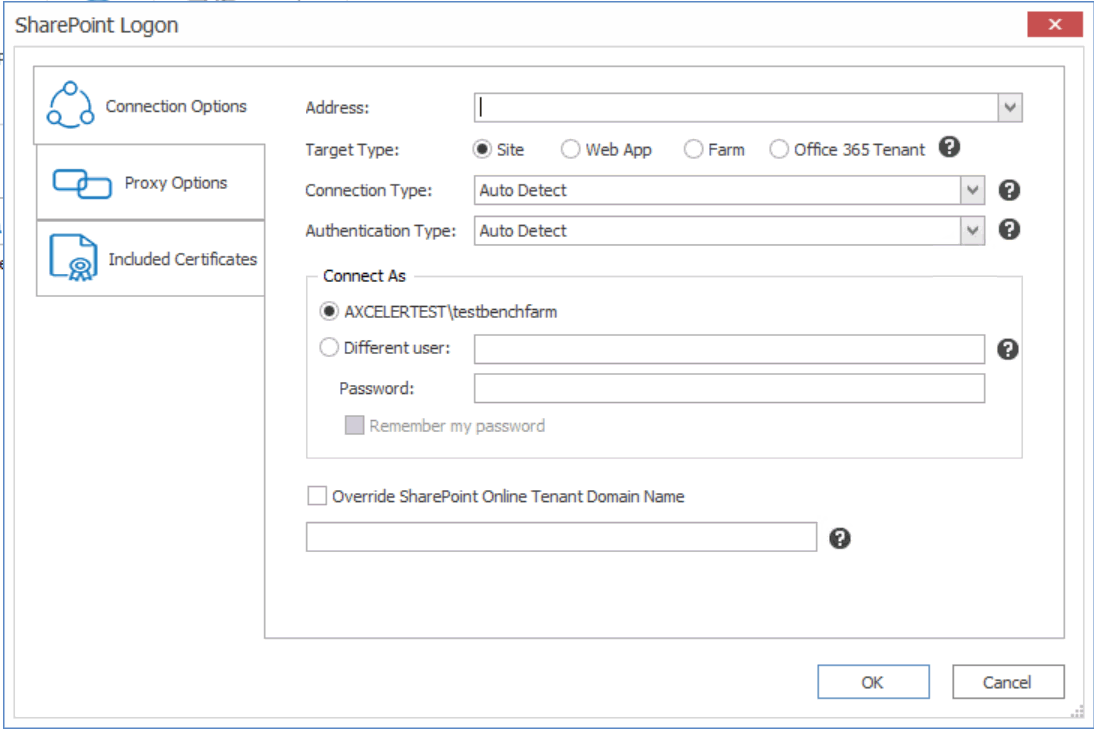
To complete the Connection Options tab:
1.For Address, enter either the URL or IP address of the SharePoint site or server to which you want to connect.
Note that the drop-down menu displays a list of previous connections.
2.For Target Type, select the connection type. Use the information in the following table for guidance.
|
If you want to connect |
Select |
|---|---|
|
directly to a SharePoint site |
Site.
|
|
to a specific Web application on a SharePoint server |
Web App.
NOTE: This option can only be used if using the Local or Metalogix Extensions Web Service connection type. |
|
to a SharePoint instance at the Farm/server level (which will allow you to see all site collections for all Web Application on the selected server) |
Farm.
NOTE: This option can only be used if using the Local or Metalogix Extensions Web Service connection type. |
3.Select a Connection Type from the drop-down. Use the information in the following table for guidance.
|
If |
Select |
Notes |
|---|---|---|
|
you want to have Metalogix Content Matrix choose the connection adapter type that makes the most sense for the target SharePoint instance |
Auto Detect |
·If the SharePoint instance is local (installed on the same machine as the Metalogix Content Matrix Console), the Local Connection (SharePoint Object Model) will be used ·If the SharePoint instance is remote (installed on another machine), and the Metalogix Extensions Web Service is installed, the Remote Connection (Metalogix SharePoint Extensions Web Service) type will be used. |
|
Metalogix Content Matrix Console is installed locally (that is, on the same SharePoint server or one of its Web Front Ends (WFEs) |
Local Connection (SharePoint Object Model) |
This connection type ·is generally recommended for the target SharePoint instance if possible, to help with performance and to help provide the product with greater leverage into SharePoint. AND ·the account used for the connection. must be the logged in user and have the following permissions: ·Farm Administrator ·Site Collection Administrator ·DB_Owner on the Content Database (to allow the connecting user access to the local SharePoint Object Model). NOTE: If StoragePoint is installed and running on the same SharePoint instance, the connecting account must also have access to the BlobStore, as well as both DataReader and DataWriter permissions to the Metalogix StoragePoint Database. |
|
·Metalogix Content Matrix Console is not installed locally AND ·Metalogix SharePoint Extensions Web Service (MEWS) is installed on the SharePoint server/WFE to which you are connecting |
Remote Connection (Metalogix SharePoint Extensions Web Service) |
The connecting account requires Full Control over the content being connected to and migrated. Additional permissions are provided through the use of the Metalogix Extensions Web Service. NOTE: Although it is strongly recommended that the version of the Metalogix Extensions Web Service (MEWS) match the installed version of Content Matrix, you can override it to use an earlier MEWS version. |
NOTE: As of version 9.5, Content Matrix no longer supports CSOM connections to SharePoint on premises. The option will work for backward compatibility with existing jobs, but if you select it for a new connection, a pop-up warning will display.
4.For Authentication Type, select the method to use when trying to connect to the specified SharePoint instance.
Use the information in the following table for guidance.
|
If |
Select . |
Notes |
|---|---|---|
|
you want Metalogix Content Matrix to automatically check against the SharePoint environment |
Auto Detect |
Metalogix Content Matrix will check for non-Office 365 authentication types listed in the drop-down (in order), and use the first method that is found. |
|
you want to connect to the SharePoint environment using the currently logged in Windows users credentials |
Windows Authentication |
·The logged in user credentials are used by default; however, other credentials that use this authentication method can also be entered. ·This is the authentication type that most environments use. |
|
·you selected Metalogix SharePoint Extensions Web Service as the Connection Type AND ·you want to connect using Forms Based Authentication |
Forms Based Authentication |
·Most setups for Forms Based Authentication are supported. ·This method is limited to the Metalogix SharePoint Extensions Web Service connection type because it authenticates through IIS and not Active Directory (AD). |
|
Web Browser Authentication (Not Auto Detected) |
This option is not searched for within the Auto Detect option, and needs to be manually set. In order for the Metalogix Content Matrix Console to logon to the system, users must have logged on to the system being connected to through the web browser on that system first (only before the initial connection). Since this is all done using the Web browser for authentication, the credentials section of the window will be grayed out (since it is not needed), and it is limited to the MetalogixSharePoint Extension Web Services Connection Type because it authenticates through IIS and not the Active Directory (AD).
NOTES: ·Select this Authentication Type if you are using Okta authentication. ·Because this connection method uses cookies from the browser, it may require multiple logins when running a single migration. However, this is only likely if the migration is running for a long session; this is mainly determined by the web browser settings for authentication. In the event that a login is required, a dialog box appears that lets users log in. After the user logs in, the migration will continue from where it left off. ·If you are planning to run a job using a PowerShell script, make sure the PowerShell console is closed before you make the connection using this method. Otherwise, an error will occur when you attempt to run the PowerShell job. |
5.For Connect As, enter/select the login credentials you want to use to connect to the SharePoint site/server. Use the information in the following table for guidance.
NOTE: This option is disabled if you selected Local Connection (SharePoint Object Model) or Web Browser Authentication (Not Auto Detected).
|
If you want to |
Then |
|---|---|
|
use the current Windows user's authentication credential |
Select the (default) <Domain>\<user> radio button. |
|
use different authentication credentials |
·Select the Different User radio button, and ·Enter the applicable user name and Password. In cases where alternate credentials are entered, it is recommended that you select the Remember my password check box so Metalogix Content Matrix will automatically remember that user account password. This is especially important if you chose Web Browser Authentication, as credentials must be stored in the Credential Manager vault before the connection is made. |
6.If you need to configure proxy settings:
a)Select the Proxy Options tab.
b)Follow the procedure for Configuring Proxy Settings.
7.If you want to Add or Remove certificates to be included when connecting to SharePoint:
a)Select the Included Certificates tab.
Please see the Connecting with Certificates for more details on connecting to SharePoint instances that require certificates.
b)After all of the desired connection options have been set, for all options tabs, click [OK] to establish the connection.
If you selected a connection type other than Site, the Limit Site Collections dialog displays, giving you the option to limit the site collections to include in your connection (when importing an xml file with the list of URLs you want to include). This is useful if the environment you are connecting to includes a very large number of site collections. In this case, limiting displayed site collections can improve performance.
NOTE: If you want to View Sample xml, click the link on the dialog. The xml file you import must follow the same format as this sample.
8.Either:
§Click [Yes Import from XML] to specify the URLs of the sites you want to include in the connection, then browse/upload the file
OR
§Click [No Continue with Connection] to add all sites within the selected scope to the connection.
If Metalogix Content Matrix successfully makes the connection, a new node will appear in the Explorer View, and you can expand this node and navigate through the SharePoint objects.


